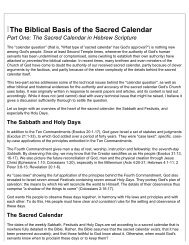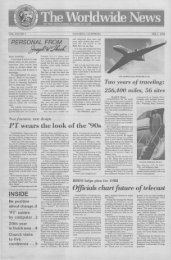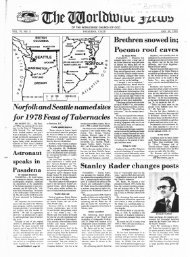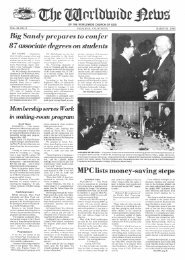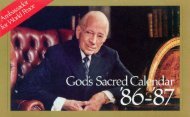PT Jan-67 - Herbert W. Armstrong Library and Archives
PT Jan-67 - Herbert W. Armstrong Library and Archives
PT Jan-67 - Herbert W. Armstrong Library and Archives
Create successful ePaper yourself
Turn your PDF publications into a flip-book with our unique Google optimized e-Paper software.
8<br />
down by a mere "sharp gust." Then it<br />
DIDN 'T SURVIVE!<br />
Bear this in mind. The bird, or<br />
repti le, or whateveritwas. didn't slIrvive.'<br />
Think further, that only TWO known<br />
examples of such a creature have ever<br />
been found. Realize further, that there<br />
is 110 proof the creature EVER DID FLY.<br />
Now notice the strange faith of<br />
ornithologists in their theories.<br />
"IN S PITE OF the patchiness of the<br />
evidence it iJ clear that birds arc closely<br />
related to the repti les. T he older forms<br />
have many characters in their skeletons<br />
that suggest their deri vation from that<br />
group" (Fossil Birds, W. E. Swinton,<br />
1965, p. 2) . (Emphasis mine throughout<br />
article.)<br />
Evolutionists admit they must SPEC<br />
ULATE about the orig in of birds. But<br />
they insist that the layman need 110t<br />
even question the validity of their<br />
theo ries!<br />
Notice! "In allefllptillg to recOIl<br />
Jlmct the ea rl y evolutionary h istory of<br />
many g roups of animals a certain eie·<br />
men! of judieiom spewlcaion ... may<br />
be a va luable weapon" (Evollttion,<br />
ed. by De Beer, p. 321).<br />
Granted, evolutionists say such con·<br />
elusions must be "constantly checked<br />
<strong>and</strong> tested with reference to such fossil<br />
types as may be knoUJn <strong>and</strong> to such<br />
characters of modern forms as may have<br />
a bearing on the subject." But if a cer·<br />
tain fossil type, COM PLETELY UN1QUE,<br />
<strong>and</strong> totally del/eloped has NO known<br />
foss il or modern counterpart, then<br />
hoUl, we mi ght as k, can "constant check·<br />
iog" <strong>and</strong> " testing" ever occur?<br />
In most books on the subject, au·<br />
thors first admit they are making<br />
"educated guesses, " <strong>and</strong> then follow<br />
with a broad, all .inclusive, sweeping<br />
statement that such <strong>and</strong> such DID<br />
POSITIVELY OCCUR!<br />
They have ALREADY DECIDED, on<br />
sheer FAITH/ that birds evolved from<br />
reptiles!<br />
Said the same author, "The reptilian<br />
ancestry of birds is so SELF·EVIDENT<br />
<strong>and</strong> so UNIVERSALLY RECOGN IZED BY<br />
ZOOLOGISTS that it can be taken as<br />
AXIOMATIC in any discussion"! (Evolution,<br />
ed. by De Beer, p. 322).<br />
So they seem to imply : "Even though<br />
I must guess, imagine <strong>and</strong> speculate-<br />
The PLAIN T RUTH<br />
YOU must assume my theory is so COR<br />
RECT that you needn't bother even thinking<br />
about it"!<br />
No Intermediate Stages Found<br />
But if our myriads of birds evolved<br />
from slimy lizards, is there any REAL<br />
fossil EVID ENCE of a part-bird, partlizard<br />
? Is there such a th ing as a<br />
HALf-scale, HALF-feather found?<br />
T hink of it this way. In any motion<br />
picture se'luence, in order for your eye<br />
to see a man walking from one side of<br />
a room to another, it necessitates many<br />
.reparate frames. Each is, actually, a<br />
"still " picture, snapped in a mere fraction<br />
of a second. Two of these frames<br />
would be all that is necessary for you<br />
to see the man, first at one side of the<br />
room, <strong>and</strong> then at the other. But in<br />
order to "see" him make the transition,<br />
you must view ALL the many frames<br />
IN BETWEEN!<br />
The fossi l " record " concerning the<br />
hazy hypothes is that supposes birds<br />
came from reptiles is much like dozens<br />
of feet of missing film! IPhere are all<br />
the many HUNDREDS of VERY DIF FER<br />
ENT creatures which would have represented<br />
the INTERMEDIATE stages of<br />
development ?<br />
And remember, IF these notions of<br />
evolu tion cou ld possibly be truethese<br />
" in termediate" stages would be<br />
NOW HE RE NEAR so well equipped to<br />
.fItrv;lIe as the "full y developed" ones.<br />
That means that if it took only a<br />
"sharp gust" to bring down "Archaeopteryx,"<br />
his imaginary ancestors would<br />
have been falling out of the ski es like<br />
bricks! And the foss il record, therefore,<br />
would contain FAR MORE " INTERME<br />
DIATE" species than it does of the ones<br />
which were supposedly "better<br />
eguipped" to survive .'<br />
But there ARE no "intermediate"<br />
species!<br />
Notice what scientists admit. "The<br />
origin of birds is largely a matter of<br />
dedllction. There IS NO FOSS1L EVI·<br />
DENCE of the stages throtlgh wh ich the<br />
remarkable change from reptile to bird<br />
was achieved" (Biology <strong>and</strong> Comparalive<br />
Phy,iology of Bird" edited by<br />
A. J. Marshal , 1960, p. 1).<br />
Scientists are eonfllsed about "Archaeopteryx."<br />
They claim this creature<br />
is part " reptile" <strong>and</strong> part "bird." Yet, in<br />
<strong>Jan</strong>uary, 19<strong>67</strong><br />
order to 11Ibstant;ate this claim, evolutionists<br />
would have to submi t positive<br />
proof of intermediate forms !<br />
But there are no such intermediate<br />
forms.<br />
Listen to this striking admission, "A<br />
certain amount of ed11eated guessUJork<br />
has been necessary to reconstruct how<br />
this ancestral bird nl1lJt have looked<br />
<strong>and</strong> behaved" (Biology of Bird" W esley<br />
E. Lanyon , 1963, pp. 2-3) .<br />
Notice it ! Not only is gliessUlot'k<br />
necessary to reconstruct how this bird<br />
must have looked, but scientists readily<br />
admit they are guessing about how it<br />
behaved. Tn other words, science does<br />
not realJy know whether this "bird"<br />
EVER Aew! It is just as likely that this<br />
creature inhabited a dry, arid region,<br />
<strong>and</strong> ran along the ground mudl like<br />
certai n birds do today, or that it was<br />
even a water bird, obtaining its food<br />
by diving <strong>and</strong> swimming.<br />
But in SPITE OF all the difficulties,<br />
ornithologists seem bent on INSISTING<br />
that "Archaeopteryx" is the " link" between<br />
DIRDS <strong>and</strong> BEASTS! Such is their<br />
faith. In any modern book on the subject,<br />
you' ll probably find arti sts' reconstructions<br />
of "Archaeopteryx." Then<br />
will follow elaborate discussions about<br />
how this <strong>and</strong> that "might have" oc·<br />
curred, <strong>and</strong> how this <strong>and</strong> that change<br />
"gradually" took place.<br />
To simply call "Archaeopteryx" another<br />
of the many UNUSUA L creatures,<br />
<strong>and</strong> place it in a SPECIAL classi.fication,<br />
has apparently never occurred to evolutionists.<br />
Rather, it is seized upon as a<br />
cOllnecting link between birds <strong>and</strong> repti<br />
les.<br />
One theory speculates ancient lizards<br />
fi rst climbed trees, <strong>and</strong> gradually extending<br />
their leaps, began to glide (by<br />
the help of scarred, broken, "halfformed"<br />
" feathers") from branch to<br />
branch.<br />
Another theory (take your pick)<br />
supposes they first began to run along<br />
the ground, <strong>and</strong> finally Rew.<br />
Science docs not d aim that all birds<br />
share ,. Archaeopteryx" as their common<br />
ancestor - believing that some of<br />
the Rightless birds of today may have<br />
come from an even more ancient "ancestor"<br />
of Archy.<br />
But notice this admission! "... it<br />
( Contilll/eel on page 44)





